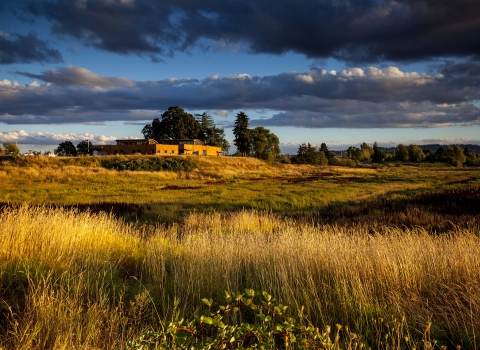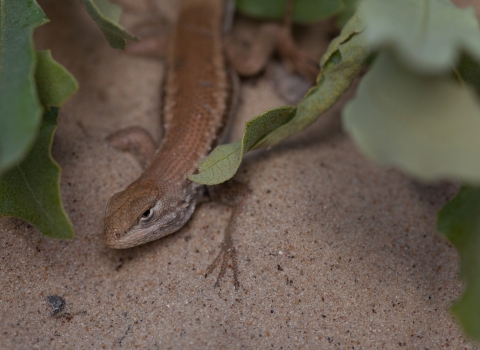ATLANTA — The U.S. Fish and Wildlife Service announced today the selection of nature-based solutions projects in the Lower Mississippi River Valley (LMRV) for forestry and wetland restoration across more than 63,100 acres of national wildlife refuges and state-managed lands in Arkansas, Louisiana, Mississippi, and Tennessee. These projects, totaling over $17 million, are part of President Biden’s Investing in America agenda and are funded through the Inflation Reduction Act-- the largest climate investment in history.
Through the Bipartisan Infrastructure Law Bipartisan Infrastructure Law
The Bipartisan Infrastructure Law (BIL) is a once-in-a-generation investment in the nation’s infrastructure and economic competitiveness. We were directly appropriated $455 million over five years in BIL funds for programs related to the President’s America the Beautiful initiative.
Learn more about Bipartisan Infrastructure Law and the Inflation Reduction Act, the Department of the Interior is implementing a more than $2 billion downpayment to restore our nation’s lands and waters. In March 2023, the Service announced an investment of more than $120 million from the Inflation Reduction Act to rebuild and restore units of the National Wildlife Refuge System and partnering with State Wildlife Management Areas that have been affected by adverse weather events. The investment prioritizes projects that promote coastal resilience and climate adaptation, address invasive species invasive species
An invasive species is any plant or animal that has spread or been introduced into a new area where they are, or could, cause harm to the environment, economy, or human, animal, or plant health. Their unwelcome presence can destroy ecosystems and cost millions of dollars.
Learn more about invasive species threats, and provide for additional data collection needed to support successful natural resource resilience.
These projects focus on rural areas and communities hit hardest by extreme weather and flooding, which are important habitat for waterfowl, migratory birds, endangered species, and freshwater fish and mussels. They also offer a chance to protect and restore natural habitats for people and wildlife alike by aiming to reduce flood and drought risks and improve access to public recreational areas.
“We are excited about the positive, immediate on-the-ground impacts and long-term benefits the Inflation Reduction Act investment will have in the Lower Mississippi River Valley,” said Mike Oetker, regional director for the U.S. Fish and Wildlife Service Southeast Region. “We collaborated with new and longstanding conservation partners to identify projects that will increase resilience to climate and severe weather conditions and will have the most impact for the wildlife, habitat and communities, particularly those underserved communities, who depend on and enjoy these important areas.”
National Wildlife Refuge System Projects:
- Arkansas: Ecological Forestry to Promote Climate Resilience at Bald Knob, Cache River, and Overflow National Wildlife Refuges, nearly $1.6 million – Partnering with USDA’s Natural Resources Conservation Service, Arbor Day Foundation, and the KKAC Organization, which works closely with historically underserved communities, the Service will restore and create healthy forests on approximately 15,100 acres. This effort will enhance outdoor recreational opportunities for the public, especially wildlife observation and photography, benefit wintering waterfowl, birds, and other species, and sequester more carbon, lessening the impact of a warming climate on local communities.
- Arkansas: Wetlands Restoration to Create, Enhance, and Protect Natural Environments Across Cache River, Dale Bumpers White River, and Wapanocca National Wildlife Refuges, nearly $2.5 million – Partnering with USDA’s Natural Resources Conservation Service; Arkansas Game and Fish Commission; the KKAC Organization, and Ducks Unlimited, the Service will restore the wetlands’ natural ability to capture, store, and safely release rainwater on approximately 5,200 acres. Refuge levees and water control structures will be removed or adapted to mitigate flooding and other effects of severe weather events. This project will prevent damage to the refuge’s forests, provide beneficial habitat for migrating waterfowl, and improve the water quality around the refuges.
- Louisiana: Ecological Forestry to Promote Climate Resilience at Black Bayou Lake, Bayou Sauvage Urban, D’Arbonne, North Louisiana Complex, and Tensas River National Wildlife Refuges, nearly $2.6 million – Partnering with Louisiana Department of Wildlife and Fisheries and Arbor Day Foundation, the Service will restore and create healthy forests on approximately 2,700 acres. Planting bottomland hardwood trees will improve the natural buffer between wildland and urban environments, restore the native fire-resilient ecosystem, increase resiliency against hurricanes and storm surge, increase biodiversity and waterfowl habitat, improve water quality, and provide opportunities for educational and public outreach programs for the community.
- Louisiana: Wetlands Restoration to Create, Enhance, and Protect Natural Environments at Upper Ouachita National Wildlife Refuge, nearly $592,000 – Partnering with local industry partners and Arkansas Game and Fish Commission, the Service will restore 10,000 acres of wetlands. Refuge earthen dam and water control structures will be removed or adapted to mitigate flooding and other effects of severe weather events. This project will prevent damage to the refuge’s forests, provide beneficial habitat for migrating waterfowl, and improve the water quality around the refuges.
- Mississippi: Ecological Forestry to Promote Climate Resilience at Dahomey and Theodore Roosevelt National Wildlife Refuge Complex, nearly $1.6 million – In partnership with the Mississippi Forestry Association, Mississippi Forestry Commission, Mississippi Department of Wildlife, Fisheries, and Parks, Ducks Unlimited, Wildlife Mississippi, and local mayors, the Service will enhance almost 11,300 acres. Improving forest health by thinning and planting native bottomland hardwood tree species will provide better habitat for wildlife, including waterfowl and threatened or endangered species, and will enhance wildlife recreational opportunities for the community.
- Mississippi: Wetlands Restoration to Create, Enhance, and Protect Natural Environments on Theodore Roosevelt National Wildlife Refuge Complex, nearly $2.3 million – Efforts to restore the wetlands’ natural ability to capture, store, and safely release rainwater on more than 2,000 acres will include removing levees and other barriers, planting native vegetation, and controlling invasive species. Working with the Mississippi Forestry Association, Mississippi Forestry Commission, Mississippi Department of Wildlife, Fisheries, and Parks, Ducks Unlimited, Wildlife Mississippi, and local mayors, the Service’s efforts will help mitigate flooding and other harmful effects of severe weather events, provide beneficial habitat for migrating waterfowl, and improve the health of the watershed used and enjoyed by local communities.
- Tennessee: Restoration of Bottomland Hardwood Forests at West Tennessee National Wildlife Refuge Complex, nearly $2.9 million – In partnership with Tennessee Wildlife Resources Agency and the Tennessee Department of Environment and Conservation, the Service will enhance more than 8,500 acres of bottomland hardwood forests across the complex by planting new trees and selective forest thinning. This will increase the climate resiliency of the bottomland forest habitats. These improved forests will benefit wildlife, including waterfowl, threatened and endangered species and provide more outdoor recreational opportunities for local communities.
State Wildlife Management Area Projects:
- Arkansas: Arkansas Game and Fish Commission’s Shirey Bay Rainey Brake Wildlife Management Area Wetland Enhancement Project, $750,000 – Partnering with Ducks Unlimited and the Service, the Arkansas Game and Fish Commission will restore approximately 2,300 acres of critical wetland habitats by installing structures that control the flow and levels of stormwater. The project will enhance the natural ability to capture, store, and safely release rainwater, water quality, and habitat for waterfowl and threatened and endangered species. These efforts will help provide outdoor recreational opportunities for the community and will provide a natural bottomland system and better water quality downstream.
- Louisiana: Forestry Enhancement Project, $750,000 – Partnering with the Service, the Louisiana Department of Wildlife and Fisheries will preserve bottomland forests at Boeuf, Dewey Wills, Richard K. Yancey, Russell Sage, and Sherburne Wildlife Management Areas. Selective forest thinning on 2,500 acres and the removal of invasive plants on 400 acres will help increase outdoor recreational opportunities for the public.
- Mississippi: $750,000– The state of Mississippi will receive $750,000 for nature-based solutions on state-managed lands. Details of these projects are still being finalized.
- Tennessee: Climate Resiliency through Progressive Forest Management, $750,000 – Partnering with the Service, Tennessee Wildlife Resources Agency will improve 3,500 acres of bottomland hardwood forest on seven Wildlife Management Areas, which include Moss Island, Tumbleweed, Eagle Lake Refuge, John Tully, Thorny Cypress, Ernest Rice, and Reelfoot. Removing undesirable tree species and thinning the forest to make room for desirable ones will restore forest health, ensure habitat for waterfowl, and threatened and endangered species, and provide outdoor recreational opportunities for the community.
Through these investments, the Service is working with state partners to complete geographically diverse, large-scale projects that are mutually beneficial for these conservation areas, including projects that benefit underserved communities and Tribal interests. The program supports the Biden-Harris administration’s America the Beautiful Initiative, a decade-long challenge to pursue locally led and voluntary conservation to protect, conserve, connect, and restore our nation’s lands, waters, habitats, and wildlife.
For more information about the Service’s Inflation Reduction Act-related efforts, visit the U.S. Fish and Wildlife Service’s website.
The U.S. Fish and Wildlife Service works with others to conserve, protect and enhance fish, wildlife, plants and their habitats for the continuing benefit of the American people. For more information, visit www.fws.gov and connect with us on social media: Facebook, Instagram, Twitter, LinkedIn, Flickr and YouTube.





